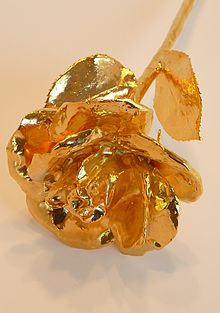This article needs additional citations for verification. (September 2016) |
Gold-dipped roses, or gold-trimmed roses, are real roses that are cut and preserved in a protective shell of gold to make them last a long time.[1] These roses are often given as gifts on special occasions like Mother's Day, Valentine's Day, wedding anniversaries, birthdays, and other celebrations and events. The idea behind gold-dipped roses is to preserve the elegance and beauty of a rose forever in a metal that is just as exquisite and valuable as the rose itself, and to make a permanent and lasting expression of the emotions expressed by the giving of roses.[2]

History
editThe concept of gold-dipped roses has been around for quite a long time.[1][specify] However, the techniques of making a rose have improved, paying special attention to intricate details, so that all the features of a rose are enhanced, protected, and beautified. If the process of gold-dipping, the rose and the gold used are of good quality, the gold-dipped rose can be made to last a lifetime.
Varieties
editOther varieties of dipped roses include silver, platinum, and even tin roses. Petals, leaves, and rose orchids are also dipped in precious metals for preservation and decoration.[1]
Procedure
editDifferent companies have different techniques and procedures for making gold-dipped roses, and most of the steps involved are patented by each company and are trade secrets.[3] Dipping or plating a rose is a time-consuming and painstaking process that involves multiple steps and weeks to prepare the finished product.[2]
Method
editSome companies[4] claim that it requires 60 steps and 3 months of delicate processing to make a gold-dipped rose, while others profess that it requires 30 days to make the end product.[5] However, the basic procedure, especially for small-scale processing, is the same; a rose, grown especially for the purpose of dipping or plating, is cut and layered with lacquer or an electrophoresing chemical and then dipped in molten gold (or another metal) to make a hard shell of metal. At the commercial level, several companies use the process of electroplating the rose with gold for a more durable and professional look. Simplified steps of the process are as below:[6]
- A healthy and purpose-grown rose which is not yet fully bloomed is selected;[6]
- The rose is hand-painted or sprayed with lacquer or an electrophoresing chemical so that the metal will stick to it, and left to dry, which may take 24 hours;[6]
- The gold is melted, and the rose is dipped into it bud-first, holding the stem, for between 60 and 90 seconds, depending upon the desired thickness of the metal. If a light coating is required, it is dipped for less than 60 seconds; for a heavier coating, it is dipped for more than 90 seconds.[6]
- An alternative method, which is especially used for commercial processing, is complete electroplating of the rose first with metals such as copper, and then a final coating of gold.
- The rose is left to dry until a hard shell is formed, which may take a couple of days, depending on factors such as wind and humidity.[6]
The idea is to preserve the delicacy, features, and pattern of the rose so that it is evident even through the gold plating.
Cost
editGold-dipped roses are available for anywhere between $69 and $299, depending on the technique and vendors, the karat of the gold that is used for dipping, and the thickness of the coating.[1] Some cheaper roses are coated with tin and then lightly sprayed with gold of a lesser quality, like 10 karat. Good quality roses are dipped in 24K gold, and hence are expensive.
References
edit- ^ a b c d Society of American Florists (1997). Floral Management. Cornell University. Retrieved 7 July 2015.
- ^ a b "House Beautiful". House Beautiful. 108. April 1966. Retrieved 7 July 2015.
- ^ "Indianapolis Monthly". Indianapolis Monthly. October 2006. Retrieved 7 July 2015.
- ^ "OUR 60-STEP PROCESS".
- ^ "How Gold Dipped Roses Are Made?". ozflowerdelivery.com.au. Retrieved 2021-03-28.
- ^ a b c d e "Micro/Nano Technology Center" (PDF). University of Louisville. University of Louisville. Retrieved 7 July 2015.[dead link]